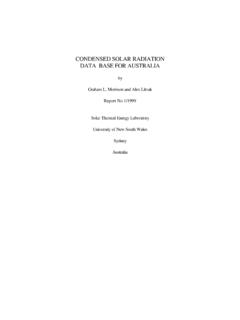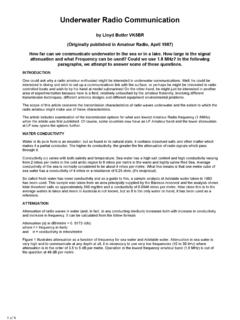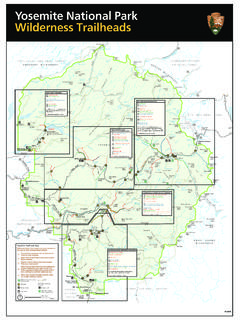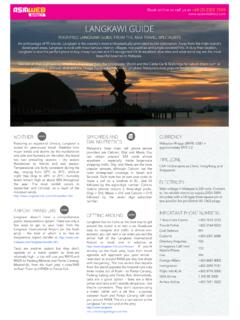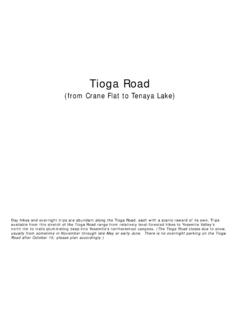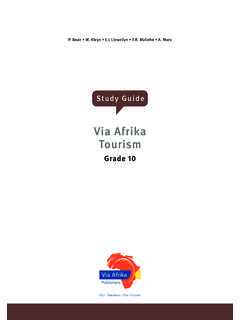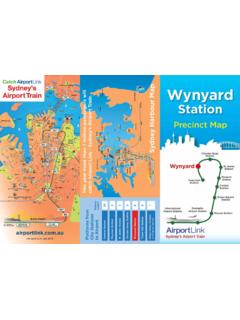Transcription of BUILDING CODE OF AUSTRALIA ON LIFTS - TPG …
1 BUILDING code OF AUSTRALIA ON LIFTS By Robert Yeoh (Monash), (NSW), GradDip Mgt(UTS) GradDipAppSc(CSU), CPEng. Senior LIFTS Engineer Department of Commerce Email: Webpage: September 2005 CONTENTS BUILDING code OF AUSTRALIA ON LIFTS 1 1 INTRODUCTION 3 2 SEPARATION OF LIFT SHAFTS 3 3 LIFTS AND STAIRWAYS IN ONE SHAFT 3 4 STRETCHER FACILITIES 3 5 EMERGENCY LIFTS 3 6 FACILITIES FOR PEOPLE WITH DISABILITIES 4 7 FIRE SERVICE CONTROL 4 8 WARNING SIGN 4 9 OPENINGS IN FIRE-ISOLATED LIFTS SHAFTS 4 10 FIRE PROTECTION IN SHAFTS AND MACHINE ROOM 4 11 APPENDIX 5 APPENDIX 1: BUILDING CLASSIFICATIONS 5 APPENDIX 2: FIRE-RESISTANCE LEVEL 5 APPENDIX 3: TYPES OF CONSTRUCTION 6 APPENDIX 4: FRL FOR LIFT SHAFTS 6 APPENDIX 5: LIFTS IN TYPE C CONSTRUCTION 6 APPENDIX 6: AS 1999 6 BUILDING code OF AUSTRALIA ON LIFTS 3 1 INTRODUCTION The BUILDING code of AUSTRALIA provides the standards for BUILDING construction in AUSTRALIA .
2 It is a performance-based code , which describes the acceptable standards of BUILDING construction. The BCA is called up in State legislations. The BCA specifies the requirements for lift installations in several areas, inter alia, fire-rating of lift shafts, emergency LIFTS and facilities for persons with disabilities. 2 SEPARATION OF LIFT SHAFTS Any lift connecting more than two storeys (more than three, if sprinklered) must be enclosed in a shaft. Lift Shafts must be enclosed by materials having a fire-resistance level (FRL) of not less than that required for the walls of a non-loadbearing shaft in the same BUILDING , except for the section of the shaft beyond the roof (if not in a fire-isolated stairway) and the bottom of a shaft. LIFTS in Type A construction, the lift shaft walls must have the FRL prescribed by Table 3 of Specification It does not matter what Class the BUILDING or whether the shaft walls are loadbearing. LIFTS in Type B construction, the lift shaft walls must have the FRL prescribed by Table 4 of Specification if they are loadbearing.
3 If they are non-loadbearing they must be of non-combustible construction. All emergency LIFTS are required to have a FRL of not less than 120/120/120. A lift wholly in an atrium, it is not required to be in a fire-isolated shaft. LIFTS in a patient care area in a Class 9a BUILDING , or a resident use area in a Class 9c BUILDING is to be in a fire-isolated shaft. In a Class 9a or 9c BUILDING that is required to be of Type A or B construction the lift shaft must have a FRL of 120/120/120. In a Class 9a or 9c BUILDING of Type C construction the shaft is to have a FRL of 60/60/60. LIFTS in Type C construction, apart from emergency LIFTS and LIFTS in patient care and resident use areas, need not be in a fire-isolated shaft. 3 LIFTS AND STAIRWAYS IN ONE SHAFT A stairway and lift must not be in the same shaft if either the stairway or the lift is required to be in a fire-resisting shaft. 4 STRETCHER FACILITIES Stretcher facilities are required in one of the emergency LIFTS .
4 If no emergency lift is required and passenger LIFTS are provided, then stretcher facilities are to be provided to one lift in a BUILDING with an effective height of more than 12 metres. Where there is just a single emergency or passenger lift that lift must have stretcher facilities. The minimum dimensions of 600 mm wide x 2000 mm long x 1400 mm high above the floor must be provided to accommodate a stretcher. Normally a lift car of 2000 mm deep is provided. 5 EMERGENCY LIFTS At least one emergency lift must be provided in a BUILDING with an effective BUILDING code OF AUSTRALIA ON LIFTS 4 height of more than 25 m and in a Class 9a (Health-care) BUILDING . An emergency must serve all floors served by the passenger lift. If two or more passenger LIFTS are installed at least two emergency LIFTS must be provided. If two or more passenger LIFTS are located within different shafts, at least one emergency lift must be provided in each shaft.
5 An emergency lift must have a car capacity of at least 600 kg, if BUILDING more than 75 m! (need clarification.) For Class 9a BUILDING the minimum car dimensions must be 1600 mm wide x 2280 mm deep x 2300 mm high and with a car door of 1300 mm x 2100 mm. The lift must be connected to a standby supply (if installed). 6 FACILITIES FOR PEOPLE WITH DISABILITIES The Lift code provides comprehensive requirements on LIFTS for persons with disabilities. However, the BCA only calls up five items and they are: 1. A handrail; 2. Minimum car dimensions of 1100 mm wide x 1400 mm deep; 3. minimum door opening of 900 mm wide; 4. a car door infra-red protection between 50 mm and 1550 mm above floor level; 5. car control buttons complying to Section 7 with respect to- Height of landing button 900 to 1200 mm from the floor. Height of car control button 700 to 1250 mm from the floor. Design: size, project, surface etc of the buttons.
6 7 FIRE SERVICE CONTROL All passenger LIFTS must be provided with fire service control. 8 WARNING SIGN All passenger LIFTS must be provided with a warning sign at every landing. DO NOT USE LIFTS IF THERE IS A FIRE (min. 10 mm high) or Do not use LIFTS if there is a fire (min. 8 mm high) 9 OPENINGS IN FIRE-ISOLATED LIFTS SHAFTS Any doorway leading into a fire-isolated LIFTS shaft must be protected by fire doors. The lift landing doors must to be tested for integrity. (The fire rating is one hour.) Lift indicator panels in excess of 35 000 sq mm must have backing by material having a FRL of -/60/60. 10 FIRE PROTECTION IN SHAFTS AND MACHINE ROOM The BCA is generally silent on sprinkler system. However AS , Automatic Fire Sprinkler Systems (Clause ) requires sprinklers at the top and bottom of lift shafts and in machine rooms. BUILDING code OF AUSTRALIA ON LIFTS 5 11 APPENDIX APPENDIX 1: BUILDING CLASSIFICATIONS Class 1a Single dwellings.
7 Class 1b Boarding houses, guesthouses, hostels. Class 2 Two or more sole-occupancy. Class 3 Boarding houses, guest houses, hostels, lodging-houses or backpackers accommodation. A residential part of a hotel, motel, a school, a health-care BUILDING or a detention centre. Buildings for the aged, children or disabilities accommodation. Class 4 A dwelling part of a BUILDING in Class 5, 6, 7, 8 or 9. Class 5 Office buildings. Class 6 Shop or other buildings for the sale of goods, restaurant, bar, barber's shop, laundry, market, showroom, and service station. Class 7a Car parks. Class 7b Storage or display of goods. Class 8 Laboratories, production areas. Class 9a A health-care BUILDING . Class 9b Assembly buildings, trade workshops, laboratories in schools. Class 9c Aged care buildings. Class 10a Non-habitable buildings: private garages, carports, and sheds. Class 10b Fences, masts, antennas, retaining or freestanding walls, swimming pools.
8 APPENDIX 2: FIRE-RESISTANCE LEVEL Fire-resistance level (FRL) means the grading periods in minutes for the following criteria - (a) structural adequacy; and (b) integrity; and (c) insulation, BUILDING code OF AUSTRALIA ON LIFTS 6 APPENDIX 3: TYPES OF CONSTRUCTION Type A construction is the most fire-resistant; Type C construction is the least fire-resistant, and Type B construction falls between these two. BCA s Table on Type of Construction Required Rise in storeys Class of BUILDING 2, 3, 9 5, 6, 7, 8 4 or more A A 3 A B 2 B C 1 C C APPENDIX 4: FRL FOR LIFT SHAFTS BCA s Table 3 on Type A Construction and FRL of Lift Shafts BUILDING element Class of BUILDING - FRL.
9 (min) Structural adequacy/Integrity/Insulation 2, 3 or 4 5, 7a or 9 6 7b or 8 Fire-resisting lift and stair shafts- Loadbearing 90/ 90/ 90 120/120/120 180/120/120 240/120/120 Non-loadbearing - / 90/ 90 - /120/120 - /120/120 - /120/120 BCA s Table 4 on Type B Construction and FRL of Lift Shafts BUILDING element Class of BUILDING - FRL: (min) Structural adequacy/Integrity/Insulation 2, 3 or 4 5, 7a or 9 6 7b or 8 Fire-resisting lift and stair shafts- Loadbearing 90/ 90/ 90 120/120/120 180/120/120 240/120/120 Non-loadbearing - / 90/ 90 - /120/120 - /120/120 - /120/120 APPENDIX 5: LIFTS IN TYPE C CONSTRUCTION In Type C construction need not be in a fire-isolated shaft, except for emergency LIFTS and LIFTS in patient care construction. APPENDIX 6: AS 1999 Clause of (Automatic fire sprinkler systems) requires lift shafts inside or in communication with buildings to be provided with sprinklers at the top and bottom of lift shafts and in sheave rooms.
10 Sprinklers shall be protected by stout metal guards and have a temperature rating of not less than 100 C.



